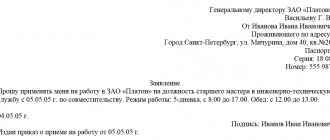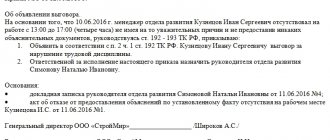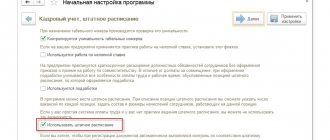Labor legislation does not oblige all employers to develop job descriptions. However, in practice, many organizations and entrepreneurs have already appreciated the benefits of such instructions. This document becomes especially relevant when a labor dispute arises. If it is necessary to prove that an employee did not fulfill his job duties, it is necessary to provide the court with a clear list of them. The job description fulfills this role perfectly.
The job description performs the following tasks:
– establishment of qualification requirements for a specific position or work performed (education, work experience, special training, etc.);
– determination of the employee’s job responsibilities (range of responsibilities, scope of work, areas for which the employee is responsible, etc.);
– establishing limits of employee responsibility.
Why are job descriptions and orders for their approval needed?
The role of job descriptions is quite clear and simple: they clearly state the tasks that company employees in one position or another are required to perform, as well as the working conditions accompanying their activities.
At the same time, job descriptions are not strictly necessary documents, but they are widely used and apply to representatives of any profession. Their presence makes it possible to protect the employer from unfounded claims from subordinates, and employees, in turn, from excessive workload and the performance of functions that are not part of their direct responsibilities.
Job descriptions are developed individually in accordance with the company's staffing table and approved by order of management - without this document they do not enter into legal force.
At the same time, all job descriptions may periodically change in terms of the information they contain, depending on the needs and current situation at the enterprise, but adjusted documents also need to be approved by order of the manager.
It should be noted that the information entered into these documents must strictly comply with the framework of the legislation of the Russian Federation and in no way violate the civil and labor rights of employees.
That is why the preparation of job descriptions is usually the responsibility of the heads of structural units, and then transferred for review and approval by the company’s in-house legal counsel or a third-party lawyer - this measure excludes the presence of gross errors and conditions that violate the rights of employees.
In what cases is a job description required?
For certain categories of employees, in accordance with the law, the employer is required to draw up job descriptions.
For example, this applies to: – medical workers (clause 1, part 2, article 73 of Federal Law No. 323-FZ of November 21, 2011);
– private security guards (Part 2, Clause 1, Part 3, Article 12.1 of the Law of the Russian Federation No. 2487-1 of March 11, 1992, Order of the Ministry of Internal Affairs of Russia No. 960 of August 22, 2011);
– workers involved in the production, storage, transportation, sale and disposal of milk and its processed products (Clause 2, Article 23 of Federal Law No. 88-FZ of June 12, 2008);
– employees of pharmacy organizations engaged in retail trade in medicines (clause 9.8 of OST 91500.05.0007-2003).
If the obligation to draw up job descriptions is provided for by regulatory documents, in the absence of instructions the employer may be held accountable for violating labor legislation (Article 5.27 of the Code of Administrative Offenses of the Russian Federation).
For other employees, the legislation does not provide for the obligation to draw up a job description. But it is advisable to draw up and approve it, especially if the employment contract with the employee does not disclose his labor function, but only indicates the name of the position, profession, specialty (paragraph 3, part 2, article 57 of the Labor Code of the Russian Federation, letter of Rostrud No. 6234-TZ dated November 24, 2008). Job descriptions can be drawn up for all positions provided for in the staffing table, including vacant ones. For specialist positions (for example, accountant, engineer, lawyer), job descriptions must be drawn up and approved. And for the professions of workers (for example, driver, electric and gas welder, loader) - instructions for the profession (production instructions). However, it is not prohibited to call instructions for a profession also job descriptions.
Sample instructions for various positions and professions can be found on the website www.moedelo.org. Based on them, it is easy to develop your own instructions, adding, if necessary, the specifics of a particular organization or industry.
Comment: – As a general rule, the absence of job descriptions in an organization is not regarded as a violation of labor legislation and does not entail liability. However, some employer decisions without job descriptions may be considered illegal. For example, refusal to hire applicants due to their failure to meet qualification requirements in the absence of these requirements themselves, which, as a rule, are contained in the job description. This is confirmed, for example, by Rostrud letter No. 3042-6-0 dated August 9, 2007. When resolving labor disputes regarding the dismissal of an employee due to an unsatisfactory test result, the courts, as a rule, require the presentation of a job description, as well as evidence of the employee’s familiarization with it when employment. If the employee was not familiar with the scope of his duties, it is not possible to prove that he did not complete the probationary period (see, for example, the Appeal Determination of the Moscow City Court No. 11-11709 of June 26, 2012).
Is it possible to replace an order with another form of approval?
An order, like the job description itself, is not a mandatory document, so sometimes, instead of writing a separate administrative paper, it is enough to simply put the manager’s resolution on the job description.
However, if the enterprise is large, having a number of structural divisions, employees and, accordingly, many positions fixed in the staffing table, it is much easier and more convenient for the director to put job descriptions into effect with one order than to endorse dozens of separate documents.
Who writes the order directly
An order for approval of job descriptions can be drawn up by any employee of the organization who is assigned this function:
- legal adviser,
- HR specialist,
- secretary, etc.
The main condition is that a person has a clear idea of how to correctly draw up and execute this document.
After writing the order, it must be submitted to the director of the company for signature, since without his autograph the order will not be considered valid and subsequently it can easily be challenged in court.
How to write an order
Today there are no standards for drawing up orders approving job descriptions. So enterprises and organizations can write this document in any form or use a sample approved in the company’s accounting policies. However, some information is still required to be included:
- number,
- date and place of compilation,
- Company name,
- a complete list of job descriptions approved by the order.
The document should indicate the persons responsible for its implementation (this part concerns familiarization with the job descriptions of the company’s employees), and the job descriptions themselves, if necessary, can be noted as a separate paragraph as an appendix to the order. In addition, the order can be supplemented with any other necessary information.
What is a job description useful for?
If there is a job description, the employer can:
– justify the refusal to hire due to the non-compliance of the applicant (applicant for the position) with the established qualification requirements for a certain position or work performed;
– objectively evaluate the employee’s activities during the probationary period;
– distribute labor functions among employees;
– assess the integrity and completeness of the employee’s performance of his or her job function;
– justify the employee’s inadequacy for the position held or the work performed due to insufficient qualifications confirmed by certification results;
– justify the legality of applying a disciplinary sanction to an employee for failure to perform or improper performance of his job duties (including dismissal) (Rostrud letters No. 3042-6-0 dated August 9, 2007, No. 6234-TZ dated November 24 2008, No. 1028-s dated April 30, 2008).
How to store an order
An order is usually created in a single copy and then registered in the journal of internal documents of the organization. During the period of validity, the order must be kept together with all other administrative documentation of the company in a place to which access must be limited. After losing its relevance, it is transferred to the archive of the enterprise, where it is stored for the period established by law or local regulations of the company (but not less than three years), after which it can be disposed of.
What sections does the job description consist of?
General provisions.
This section includes:
1) the procedure for appointment to a position and dismissal from a position. Determined in accordance with regulatory legal acts, internal labor regulations, regulations on the structural unit (if such regulations are developed and approved by the employer), other local regulations of the employer (for example, it may be stipulated that an employee is appointed to a position and dismissed from position by order of the manager organization on behalf of a certain official);
2) requirements for the employee’s qualifications. The level of professional training of the employee necessary to perform the provided job duties (education, advanced training), requirements for length of service, work experience in any field of activity are indicated;
3) requirements for the employee’s knowledge (“must know”). The basic requirements for the employee are indicated in relation to special knowledge, as well as knowledge of legislative and regulatory legal acts, regulations, instructions and other guidance materials, methods and means that the employee must use when performing job duties;
4) a list of documents that the employee must follow when performing his job duties. As a rule, this list includes:
– legislation of the Russian Federation;
– local regulations of the employer directly related to the employee’s work activity (including internal labor regulations);
– regulations on the structural unit that includes the position (see, for example, Regulations on the personnel service (HR department));
– orders and instructions of the head of the organization;
– orders of the head of the structural unit;
– direct job description;
– other documents;
5) the employee’s place in the chain of command (if any, the superior official to whom the employee reports, as well as persons who are subordinate to the employee are indicated);
6) the procedure for appointing an employee who will be assigned the duties of this employee during the period of his temporary absence (for example, during vacation, temporary disability, business trip, etc.);
7) the category to which a specific position belongs (manager, specialist, technical executive).
Job responsibilities.
This section should include a list of duties that the employee must perform as part of his job function.
The job description reveals the concept of the employee’s labor function, determined by the employment contract concluded with him (paragraph 3, part 2, article 57 of the Labor Code of the Russian Federation). If the employment contract, as a rule, specifies only the main characteristics of the job function (work according to the position in accordance with the staffing table, profession, specialty indicating qualifications), then in the “Job responsibilities” section of the job description the job function is regulated in detail, providing for the range of responsibilities of the employee , volume of work, areas for which the employee is responsible, etc.
As a basis for developing this section of the job description, it is advisable to use the qualification characteristics contained in qualification reference books, for example, in the Qualification Directory of Positions of Managers, Specialists and Other Employees, Approved by Resolution of the Ministry of Labor of Russia No. 37 of August 21, 1998, etc. Labor responsibilities of the employee it needs to be described specifically, in detail and understandably for the performer.
When developing job descriptions, it is possible to clarify the list of works that are characteristic of the corresponding position (profession) in specific organizational and technical conditions. Thus, if necessary, you can distribute the responsibilities contained in one qualification characteristic between several employees (performers) or supplement the responsibilities provided for by the qualification characteristic for one position with the responsibilities provided for in the characteristics for other positions. Also, the employee’s job description may provide for the obligation to replace an employee with a similar job function during the period of his temporary absence.
Comment: The employee’s obligation to resign for certain reasons (including at his own request) upon the occurrence of any circumstances does not relate to the labor function and cannot be included in the job description. In addition, this provision directly contradicts the Labor Code of the Russian Federation. The employee has the right to terminate the employment contract on his own initiative, but not the obligation to do so for any production reasons (Article 80 of the Labor Code of the Russian Federation). The desire to quit must be a voluntary expression of the employee's will. On this issue, Rostrud provided clarifications in letters No. 6234-TZ dated November 24, 2008, No. 3520-6-1 dated November 30, 2009, the texts of which can be found on the website www.moedelo.org.
Rights.
This section includes:
– the employee’s right to get acquainted with the draft decisions of the head of the organization relating to his activities;
– request and receive from employees of structural divisions of the organization documents and information necessary to fulfill his job duties;
– contact the head of the organization with proposals on issues within his competence;
– demand from your immediate supervisor and the head of the organization to provide assistance in the performance of their official duties and the exercise of rights, etc.
For some categories of employees (lawyer, deputy head of an organization, etc.), this section of the job description includes the employee’s right to sign (visa) documents on issues within his competence.
Responsibility.
This should include types of employee liability for failure to comply with the requirements of the job description and other local regulations of the employer, orders and instructions of the head of the organization, as well as violations of labor discipline by the employee. It is also possible to provide provisions that clarify and specify the responsibility of an official for certain violations. For example, if an employee bears financial liability on the basis of a concluded agreement on full individual financial liability, it is also advisable to indicate this in this section.
The basis for the development of this section of the job description is the legislation of the Russian Federation on various types of legal liability. In accordance with Art. 419 of the Labor Code of the Russian Federation, liability is divided into material, disciplinary, administrative, civil, and criminal. As a rule, the wording in this section is given in general terms or indicating for which violations what type of responsibility is assigned to the employee.









